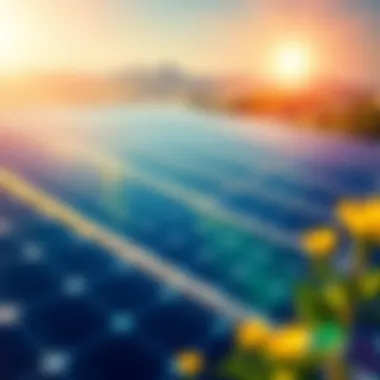Exploring Sustainable Energy Sources for a Greener Future


Intro
In a modern world that grapples with climate change and the quest for energy independence, sustainable energy sources have taken center stage. This exploration seeks to illuminate various options, shining a light on their benefits and the hurdles that accompany them. Current energy practices are under scrutiny, and a shift toward renewable options is not just prudent; it's essential for a sustainable future. This narrative will dissect key energy sources like solar, wind, hydropower, and bioenergy, presenting a detailed comparison of their environmental impact and future potential.
Sustainable energy is not merely a matter of ethics or environmental responsibility; it's become a crucial economic imperative. For instance, stakeholders ranging from policymakers to investors are increasingly prioritizing these energy forms. With the global energy landscape evolving at a frantic pace, understanding the nuances of this transition cannot be overstated.
As we embark on this journey through the intricacies of sustainable energy sources, we'll delve into the technological advancements that are reshaping these industries and the economic implications that arise. Furthermore, we will touch on the regulatory challenges that might impede the broader adoption of these technologies, emphasizing the need for cohesive policies that promote sustainability and innovation. From identifying key terminologies to outlining investment strategies, this exploration is designed to equip both novice and seasoned investors with the insights necessary for navigating the ever-evolving energy landscape.
Preamble to Sustainable Energy
Sustainable energy is the cornerstone of a future where our reliance on fossil fuels is diminished and where energy production meets the needs of the present without compromising the ability of future generations to do the same. It's a topic of urgency, relevance, and importance in today's world, where climate change looms large and the demand for energy continues to escalate.
At its heart, sustainable energy is about recognizing the delicate balance between energy consumption and environmental stewardship. It comprises various sources like solar, wind, hydropower, and bioenergy, all of which offer cleaner alternatives to conventional energy practices. Each of these sources brings unique advantages and challenges, and exploring them deeply becomes paramount as we navigate this transition.
In this article, we aim to highlight the importance of sustainable energy in creating a resilient, robust future. We’ll delve into the various energy types, investigate their roles in mitigating climate change, and discuss their broader implications on economic sustainability. By assessing both the pros and cons, this article endeavors to paint a comprehensive picture of not only the potential of these energy sources but also the socio-political landscape surrounding them.
Defining Sustainability
When we talk about sustainability, we refer to the ability to continue a certain behavior indefinitely without depleting resources or causing harm to the environment. In the context of energy, this translates to tapping into sources that are renewable and can be naturally replenished over time.
Consider the analogy of a well-tended garden—when nourished properly, it yields fruits and flowers without exhausting the soil. Similarly, sustainable energy seeks to operate within the earth's natural cycles, aiming for harmony between energy production and ecological health. This is crucial for maintaining biodiversity and protecting natural ecosystems.
Importance of Sustainable Energy
The significance of sustainable energy cannot be overstated. As the world grapples with rising temperatures, erratic weather patterns, and a host of environmental challenges, the call for immediate action has never been louder. Relying on fossil fuels not only contributes to greenhouse gas emissions but also leaves economies vulnerable to volatile markets and geopolitical tensions.
Imagine a scenario where towns thrive on locally produced solar or wind energy; they would not only become more self-sufficient but also generate jobs and stimulate local economies. Moreover, transitioning to sustainable energy sources can lead to a decrease in air pollution, promoting better public health outcomes and enhancing the quality of life for all.
"Switching to renewable energy is not just a choice; it is a necessity for a sustainable future."
In summary, sustainable energy is fundamental to ensuring that we forge a path forward that is both environmentally sound and economically viable. The subsequent sections will comprehensively cover various types, their advantages, limitations, and how we might better adopt them in our society.
Types of Sustainable Energy Sources
Understanding the types of sustainable energy sources is vital in gaining insights into how we can shift our dependence from fossil fuels to cleaner alternatives. Each type plays a distinct role in diversifying energy supply, reducing carbon footprints, and enhancing energy security. By diving into the specifics of sources like solar, wind, hydropower, biomass, and geothermal energy, we can better appreciate their unique offerings.
Sustainable energy isn't just a catchphrase; it's a pressing need, especially in the context of climate change and energy consumption. Harnessing these diverse sources allows us to meet the energy demands of today while preserving resources for future generations. The practical benefits, environmental impacts, and economic factors associated with these various sources are crucial to understanding their place in our energy landscape.
Solar Energy
Photovoltaic Systems
Photovoltaic (PV) systems enable the direct conversion of sunlight into electricity using semiconductor materials. These systems are widely regarded as one of the most popular and accessible forms of solar technology. The key characteristic of photovoltaic systems is their adaptability; they can be installed on rooftops, buildings, or even integrated into solar farms. This makes them a favorable choice for residential and commercial users alike.
One of the unique features of PV systems is their scalability. Homeowners can install a small number of panels or invest in larger installations. The advantages include low maintenance costs and decreasing installation prices, which makes it increasingly appealing to homeowners and investors. However, one disadvantage is that PV systems can be dependent on sunlight availability, meaning energy production can fluctuate significantly.
Concentrated Solar Power
Concentrated Solar Power (CSP) harnesses solar energy by using mirrors or lenses to concentrate sunlight, generating heat that produces electricity. This technology is especially beneficial for large-scale energy production given its ability to generate energy even when sunlight isn't directly available due to thermal storage capabilities. CSP plants can provide power during peak demand hours, enhancing their reliability.
The unique feature of CSP is its ability to offer utility-scale solutions, making it a compelling choice for energy providers looking to supply large amounts of clean energy. However, CSP requires a considerable amount of land and is most efficient in regions with high solar irradiance, which may present geographical limitations.
Wind Energy
Onshore Wind Farms
Onshore wind farms are installations situated on land where wind turbines convert kinetic energy from the wind into electricity. A significant characteristic of onshore wind energy is its relatively low cost of installation, particularly in regions with substantial wind resources. This makes it a valuable option for countries looking to expand their renewable energy portfolio.
The unique aspect of onshore wind farms is their relatively quick installation process compared to other renewable projects. However, these farms may face issues related to land use and can sometimes be met with local opposition regarding noise and aesthetic impact from nearby communities.
Offshore Wind Farms
Offshore wind farms are situated in bodies of water, where winds tend to be stronger and more consistent than on land. This quality makes offshore wind energy a potent player in energy generation. The key characteristic of these farms is their capability to harness wind energy without the limitations that onshore sites may face.
One unique feature of offshore wind farms is their extensive potential to produce large-scale electricity due to increased wind speeds. That said, they come with higher costs and logistical challenges, like installation and maintenance, which can complicate profitability and planning.
Hydropower


Dam-based Systems
Dam-based hydropower is perhaps the most recognized form of hydropower generation. This system stores water at a height and releases it to produce electricity. A defining characteristic of dam-based systems is their ability to provide a constant supply of energy, which can be adjusted according to demand, making them a reliable source of base-load energy.
The unique aspect of this method is the capability to support water management, such as irrigation and flood control. However, building dams can lead to significant environmental and social impacts, including habitat disruption and displacement of communities.
Run-of-the-river Systems
Run-of-the-river systems generate electricity through the flow of the river without significant water impoundment. This method is an environmentally friendly option, often seen as less disruptive than traditional dam systems. The key feature of these systems is that they maintain river flow which helps sustain aquatic ecosystems.
An advantage is their lower initial investment — often ideal for smaller projects. The downside remains a lesser amount of energy generation compared to dam-based systems and susceptibility to seasonal water flow changes.
Biomass and Bioenergy
Biogas Production
Biogas production involves the anaerobic digestion of organic materials—like food waste or manure—to produce methane-rich gas, which can be converted into energy. What's appealing about this method is that it harnesses waste materials, reducing landfill use and greenhouse gas emissions. The significant characteristic of biogas production is its dual ability to produce usable energy while addressing waste management.
The unique feature is its potential to contribute to circular economy practices. However, scaling biogas production can be complex due to feedstock availability and technological barriers.
Biofuels
Biofuels are liquid fuels derived from biological materials. This includes ethanol made from corn or sugar cane and biodiesel produced from vegetable oils or animal fats. The notable characteristic of biofuels is their adaptability; they can often be used with existing combustion engines, making them a practical option for transportation.
The unique aspect of biofuels is that they can reduce dependency on fossil fuels and support rural economies. However, a notable downside can be the competition for arable land, which raises concerns about food security and land use.
Geothermal Energy
Ground Source Heat Pumps
Ground source heat pumps utilize the consistent temperature of the earth to provide energy-efficient heating and cooling. This technology is increasingly embraced due to its energy-saving benefits. The defining characteristic is that it works year-round, making it a versatile option for both residential and commercial buildings.
A unique feature is that it has low operational costs and minimal environmental impact. However, its installation can come with higher upfront costs compared to traditional heating systems.
Geothermal Power Plants
Geothermal power plants harness heat from the earth's core to generate electricity. A key characteristic is their low greenhouse gas emissions during operation, marking them as a clean power source. Their unique feature is the capacity to provide continuous energy output, making it a reliable part of the energy grid, similar to fossil fuel plants.
However, geographic limitations may restrict the sites suitable for geothermal plants, and the potential for induced seismicity in some areas needs careful consideration.
By understanding these various sustainable energy sources, we can appreciate their roles and the challenges that come with them in our collective pursuit for a more sustainable energy future.
Advantages of Sustainable Energy Sources
As society evolves, there's more discussion around options to move away from conventional fossil fuels and to favourite renewable sources. This section digs into the various advantages that sustainable energy sources bring to the table, like their environmental benefits, enhanced energy independence, and economic opportunities, emphasizing the myriad reasons why shifting towards greener solutions is critical in today’s climate.
Environmental Impact
One of the most significant advantages of sustainable energy is its positive environmental impact. Unlike traditional energy sources that release greenhouse gases, sustainable energy techniques, such as solar and wind power, emit little to no pollutants. This leads to cleaner air and water, crucial for public health.
Not only does sustainable energy reduce carbon footprints, but it also helps preserve natural habitats. For instance, solar panels can be installed on rooftops, conserving land space and minimizing habitat disruption. Moreover, wind farms, particularly offshore ones, tend to have a lower ecological footprint compared to oil drilling activities. In regions that harness hydropower, careful regulation can ensure that aquatic ecosystems are not devastated.
“Transitioning to renewable energy is not merely a necessity; it is a moral obligation towards future generations.”
Energy Independence
Another vital advantage is the potential for energy independence. Many countries today import a significant portion of their energy. By investing in local renewable sources, nations can reduce their reliance on foreign energy supplies. This shift not only enhances national security but also provides protection against price volatility in global energy markets.
For example, nations that harness geothermal energy or invest heavily in solar power can tap into their resources instead of leaning on imported oil. This shift fosters a sense of sovereignty in energy affairs, allowing countries to dictate their energy futures instead of being at the mercy of fluctuating global prices.
Economic Opportunities
Job Creation
Focusing on jobs specifically, sustainable energy sectors have shown a knack for job creation. With the rapid expansion of industries like solar and wind energy, numerous job opportunities have emerged.
For instance, a solar energy installer not only benefits from steady job growth, but the job itself is often hands-on, requiring a blend of around technical skills and problem-solving. The unique feature of job creation in this area is its diverse range, catering to various skill levels. Advanced engineers, installers, sales personnel, and even maintenance workers all find niches within this expanding sector. All in all, jobs in sustainable energy not only pay the bills but also contribute positively to job satisfaction, given the knowledge that one is creating a luxurious & clean environment.
Investments in Technology


On another note, sustainable energy frequently leads to substantial investments in innovative technologies. The rising demand for renewables spurs companies to pour resources into research and development. The key characteristic of this trend is its virtuous cycle: as technology advances, production costs drop, making sustainable energy even more accessible.
A unique feature here involves the development of energy storage solutions, like advanced batteries and hydrogen fuel cells. As these technologies develop, they help ease the intermittency issues faced by solar and wind energy. The more efficient these technologies become, the more viable and popular sustainable energy sources are likely to be. Thus, investments in technology are not just beneficial; they form the backbone of any significant transition towards an energy future that is clean, efficient, and sustainable.
Limitations and Challenges
While the promise of sustainable energy is illuminated by its benefits, it’s also shrouded in shadows of limitations and challenges that can’t be ignored. Understanding these roadblocks is crucial for investors and policymakers alike, as they pave the way for informed decisions and innovative solutions. The transition to sustainable energy isn’t merely about embracing new technologies; it’s about navigating the complexities that come with them.
Intermittency Issues
One of the most talked-about limitations in sustainable energy is the intermittency issue. Take solar power, for instance. When the sun is shining, energy production flows like a river; however, when night falls or clouds roll in, that river can dry up in an instant. Wind energy faces similar trials. Wind turbines spin to generate power when the breeze is just right but grind to a halt during calm days. This inconsistency poses a fundamental challenge to the reliability of renewable energy sources.
To combat this, many are looking at storage solutions such as batteries and pumped hydro storage. Yet these technologies come with their own hurdles, including cost and scalability. Therefore, the question needs to be asked: how do we ensure a consistent supply of energy during those lulls? The solution lies not only in advancing technology but also in creating smart grids that optimize energy distribution in real time.
High Initial Costs
Another significant barrier is high initial costs. The upfront investment required for renewable energy systems can be daunting. Solar panels, wind turbines, and geothermal systems all carry hefty price tags. These costs can be particularly challenging for smaller communities or developing nations where budgets are already strained. Despite the long-term savings on energy bills, those initial expenditures can deter potential investors.
However, the landscape is gradually changing. Government incentives, like tax credits and subsidies, are making these technologies more accessible. With the right policies in place, investors can see a clearer path to profitability. For example, programs such as the Solar Investment Tax Credit in the United States have demonstrated how supportive measures can ease the financial burden and enhance adoption rates.
Land Use Conflicts
Lastly, we have land use conflicts. The land needed for wind turbines, solar farms, and bioenergy facilities often comes at a premium, leading to friction among multiple stakeholders. Agricultural land, natural habitats, and urban development all vie for space. The siting of these energy projects can lead to local opposition, as communities grapple with potential impacts on landscapes, ecosystems, and existing land uses.
This scenario raises a critical question: is it possible to balance energy needs with ecological preservation? Some regions have turned towards dual land use strategies, incorporating solar panels atop agricultural fields or installing wind turbines on non-arable land. These hybrid approaches hold promise for minimizing conflicts and maximizing energy production without compromising other valuable land uses.
In summary, while sustainable energy sources offer a bright future, they also bring forth considerable challenges that require thoughtful deliberation and innovative solutions. Addressing intermittency concerns, high initial costs, and land use conflicts is essential for realizing the full potential of sustainable energy, making these topics indispensable for any stakeholders aiming to dive deeper into the field.
"The energy transition journey is complex, and its challenges must be met head-on to unlock its full potential."
For further insightful resources about sustainable energy developments, consider visiting Wikipedia on Renewable Energy and National Renewable Energy Laboratory.
Technological Innovations
Technological innovations are shaking up the landscape of sustainable energy sources. They play a pivotal role in enhancing the efficiency, reliability, and scalability of renewable energy systems. With rapid advancements in technology, the potential to harness natural resources sustainably grows larger. These innovations also address the classic setbacks, such as storage issues and grid management, while advancing toward a world that relies less on fossil fuels.
Storage Solutions
Batteries
Batteries serve as the backbone for energy storage in sustainable systems. They store excess energy generated during peak production times, allowing for its use when generation is low. Lithium-ion batteries, in particular, have become a popular option due to their high energy density and declining costs.
One key characteristic of lithium-ion batteries is their ability to charge quickly and support repeated cycling without significant degradation. This makes them a favorable choice for solar and wind energy systems, where energy supply may fluctuate throughout the day. Moreover, recent developments in recycling processes help mitigate the environmental impact associated with battery disposal.
However, batteries aren't without their drawbacks. Issues such as raw material sourcing and long cycle life still require attention. Despite these challenges, the overall advantages of batteries, such as scalability and efficiency, secure their role in the future of renewable energy.
"As energy storage systems improve, they will enhance the flexibility and reliability of renewable energy sources, making them more viable on a large scale."
Hydrogen Storage
Hydrogen storage presents another intriguing avenue for energy storage. By converting surplus electricity into hydrogen through a process known as electrolysis, this technology allows for storing energy over longer periods. The main thing about hydrogen storage is its versatility: it can be used as a fuel, potentially powering vehicles or generating electricity when needed.
One unique feature of hydrogen storage systems is their ability to turn excess renewable energy into a storable fuel that can later be converted back into electricity or used in various applications. This capability makes hydrogen a promising player in the transition to sustainable energy.
However, hydrogen storage systems are still in the early stages of development and can be less efficient than traditional batteries. Their infrastructure for transport and storage is also less established, posing challenges for widespread adoption. Despite the hurdles, the potential benefits of hydrogen as a clean fuel source cannot be overlooked.
Smart Grids
Smart grids represent a significant leap in energy distribution and management. These modern electrical grids utilize digital technology to monitor energy flow and enhance the overall efficiency of distribution systems. By incorporating smart meters and advanced data analytics, utilities can better manage real-time electricity demand and supply.
Smart grids increase the integration of renewable sources into the energy mix and enable decentralized energy production. They allow smaller energy producers, like households with solar panels, to sell excess energy back to the grid. Moreover, they facilitate demand response strategies that encourage consumers to adjust their energy use during peak times, collectively reducing strain on the system.
The Role of Government and Policy
Government involvement plays a pivotal role in accelerating the transition to sustainable energy sources. Policymakers shape the landscape through regulations, incentives, and funding, making it easier for both businesses and consumers to adopt renewable technologies. Their influence is essential for setting the stage where sustainable energy sources can flourish amidst traditional fossil fuels. The need for government action has never been more urgent, especially as the world grapples with climate change and seeks innovative solutions.
Incentives for Renewables


Incentives are a major tool that governments deploy to encourage the adoption of renewable energy technologies. These incentives can take many shapes, but two of the most common are subsidies and tax credits.
Subsidies
Subsidies can significantly reduce the initial financial burden associated with renewable energy projects. They lower the costs for installations of solar panels, wind turbines, or bioenergy facilities. For example, governments may offer direct funding or rebates to industries or homeowners who choose green energy solutions. This kind of support not only motivates investment in renewables but also helps stimulate local economies. However, critics argue that subsidies can sometimes favor one type of energy over others, leading to possible market imbalances.
The unique feature of subsidies is their ability to directly impact the market, making renewable energy more accessible for everyone. They create a push for larger scale projects that might not see the light of day without such financial backing. In this way, subsidies serve as a crucial enabler in transitioning to a sustainable future.
Tax Credits
Tax credits represent another crucial governmental incentive. These credits reduce the financial liabilities of individuals or corporations investing in renewable energy by allowing them to deduct a certain percentage of their investment from their taxes. For example, the Investment Tax Credit (ITC) in the United States provides significant tax relief for solar energy systems.
The key characteristic of this incentive is its focus on individual empowerment. By giving consumers and businesses a direct benefit, tax credits can see a notable uptick in renewable energy adoption. The unique feature stems from its ability to enhance cash flow; with lower immediate tax obligations, individuals might feel more comfortable investing in longer-term sustainable solutions. However, these credits do have a limited lifespan and, if not renewed, can lead to ebbs and flows in renewable energy investment.
Regulatory Frameworks
Regulatory frameworks outline the laws and guidelines within which renewable energy operates. They are essential for ensuring that energy systems function efficiently and safely. Governments usually implement regulations that encourage innovation while maintaining public safety.
Such frameworks vary widely from one region to another, but they serve to establish a stable market environment. A solid regulatory landscape assures investors that their investments are secure and sustainable energy projects can proceed without unnecessary hurdles. The challenge lies in creating comprehensive regulations that don’t stifle growth but rather promote competition and transparency.
Regulatory frameworks play a crucial role in shaping the viability of sustainable energy markets. A well-structured approach can help avert missteps and direct public and private investments towards cleaner energy solutions.
Governments must continuously adapt these regulations to keep pace with technology advancements. While new policies can be tricky to implement, the overall goal remains clear: to create a supportive environment for sustainable energy that paves the way for innovation and growth in the sector.
Future of Sustainable Energy
The future of sustainable energy is a critical consideration as global energy demand continues to rise and the implications of climate change become ever more prominent. This section delves into the upcoming trends, the significance of collective efforts, and the potential avenues for investment in sustainable energy. As the world seeks alternatives to fossil fuels, understanding the dynamics of sustainable energy becomes essential for both economic and environmental reasons.
Predicted Trends
Looking forward, several trends are emerging within the sustainable energy sector. These trends not only shape the landscape of energy production but also reflect a shift in global priorities. Some key trends include:
- Decentralization of Energy Production: With advancements in technology, energy generation is becoming more localized. Communities are exploring microgrids and community solar farms, allowing them to generate their own power and lessen reliance on centralized grid systems.
- Energy Efficiency Innovations: Energy-saving technologies are continually developing. Smart appliances and building materials are being designed to consume less energy, enhancing the efficiency of existing systems.
- Integrating AI in Energy Management: Artificial Intelligence is poised to revolutionize energy systems. From optimizing grids to predicting energy demands, AI can eliminate waste and improve efficiency.
- Increased Storage Solutions: As renewable energy relies heavily on weather conditions, innovations in battery technology will be vital. Improved energy storage solutions enhance reliability, allowing surplus energy generated during peak times to be available when production dips.
Global Collaboration
As the world grapples with climate concerns, the role of international cooperation in sustainable energy has become increasingly evident. Countries are recognizing that they are in this together, and global partnerships are essential to addressing energy issues. Some pivotal aspects of this collaboration include:
- Knowledge Sharing: Nations are exchanging best practices and technological advancements, fostering the spread of innovative solutions. Platforms like the International Renewable Energy Agency and various climate summits facilitate such exchanges.
- Financial Support for Developing Nations: Investments from wealthier nations directed towards renewable energy projects in developing countries can bridge the gap in energy access. This creates a ripple effect, enabling those on the fringes of energy consumption to engage more with sustainable energy resources.
- Joint Research Initiatives: Countries are establishing partnerships for joint research projects, aimed at tackling common energy challenges. Sharing resources and expertise can lead to groundbreaking discoveries essential for transitioning towards sustainability.
Investment Opportunities
Sustainable energy is not only about protecting the environment; it also presents attractive avenues for investment. Savvy investors are identifying opportunities in this expanding sector, and some notable areas to consider are:
- Renewable Energy Companies: Investing in firms that specialize in solar, wind, or biomass energy provides the chance to capitalize on a growing market. Companies like First Solar and Vestas are leading players in these sectors, paving the way for innovation.
- Energy Storage Technologies: As renewable energy scales up, backing companies that focus on battery technologies or hydrogen storage can yield significant returns. Firms like Tesla and QuantumScape are at the forefront of this transformative market.
- Green Bonds: These investment vehicles specifically finance projects with positive environmental impacts. Governments and corporations are issuing green bonds to fund renewable energy initiatives, offering investors a low-risk opportunity with ethical implications.
- Emerging Markets: Countries in Asia, Africa, andLatin America are increasingly adopting renewable energy solutions. Investing in these markets can provide strategic advantages as they develop their energy infrastructures.
"The transition to sustainable energy is not just an opportunity; it's a necessity for our survival."
The future of sustainable energy is bright, with innovations brewing and collaborations strengthening. By harnessing the potential of these trends and investments, we can work towards a sustainable future that benefits both the planet and economies worldwide. By understanding these shifts, investors and policymakers can make informed decisions to foster a greener world.
Closure and Reflection
In wrapping up this exploration of sustainable energy sources, it's crucial to underscore the importance of integrating thoughtful reflection into the conversation about energy production. Transitioning towards sustainable practices isn't just a trend; it's a necessity for the well-being of our planet and future generations. Acknowledging this necessity also prompts both individual and collective action towards more responsible energy consumption.
A few key elements stand out in this discussion:
- Environmental Health: Sustainable energy sources play a major role in reducing greenhouse gas emissions and air pollutants, contributing to cleaner air and a healthier ecosystem. Recognizing the link between energy choices and environmental impact can inspire changes in behavior and policy.
- Economic Viability: The conversation around sustainable energy isn't merely about doing what's right for the planet; it's equally important to consider the economic implications. Renewable energy sectors are often tied to job creation and investment opportunities. This dual focus can drive policy changes that support the growth of these industries.
- Continued Innovation: The journey to sustainable energy is not without its challenges, but technological advancements and innovations give hope. Investing in research and development allows for improvements in efficiency and reductions in costs, making renewables even more accessible.
This article has laid a foundation for understanding the intricacies of sustainable energy. Grasping these aspects is not just beneficial, it's mandatory for anyone looking to navigate the current and future landscapes of energy production effectively. As consumers, investors, or simply as stewards of the planet, we all have a part to play in this charged dialogue.
Summary of Findings
Throughout this article, we've dove deep into various sustainable energy sources such as solar, wind, hydropower, and bioenergy. Each has its unique advantages and hurdles:
- Solar Energy: Harnessing sunlight offers immense potential but is heavily influenced by geographical and climatic factors.
- Wind Energy: A burgeoning sector that capitalizes on the natural wind flow, though it faces challenges related to land use and wildlife impact.
- Hydropower: Reliable and established, but often at odds with ecological concerns.
- Biomass: Offers a dual benefit by utilizing waste, yet raises questions about sustainability in production methods.
The analytical angle taken herein highlights the relevance of various renewable resources, providing clarity on their roles in combating climate change and fostering economic growth.
Final Thoughts on Energy Transition
Energy transition is more than just a buzzword. It embodies a shift in mindset, urging us to look beyond fossil fuels and toward sustainable solutions. Here are some final reflections on this pivotal shift:
- Collective Action: Both governments and individuals need to band together. Policies can create the framework, but grassroots movements often drive the demand for sustainable energy.
- Investment in Education: Understanding the technologies, policies, and economic factors surrounding sustainable energy ensures informed decision-making. Knowledge translates to empowerment.
- Long-term Vision: Sustainable energy is not solely about short-term gains; it requires a commitment to long-term outcomes. Investing in renewables today is essentially paving the way for a secure energy future.
As we enter this new era, maintaining a dialogue on sustainable energy will be crucial. Keeping our eyes on the horizon, we can look to a future where energy is not just sustainable but also equitable and accessible for all.



